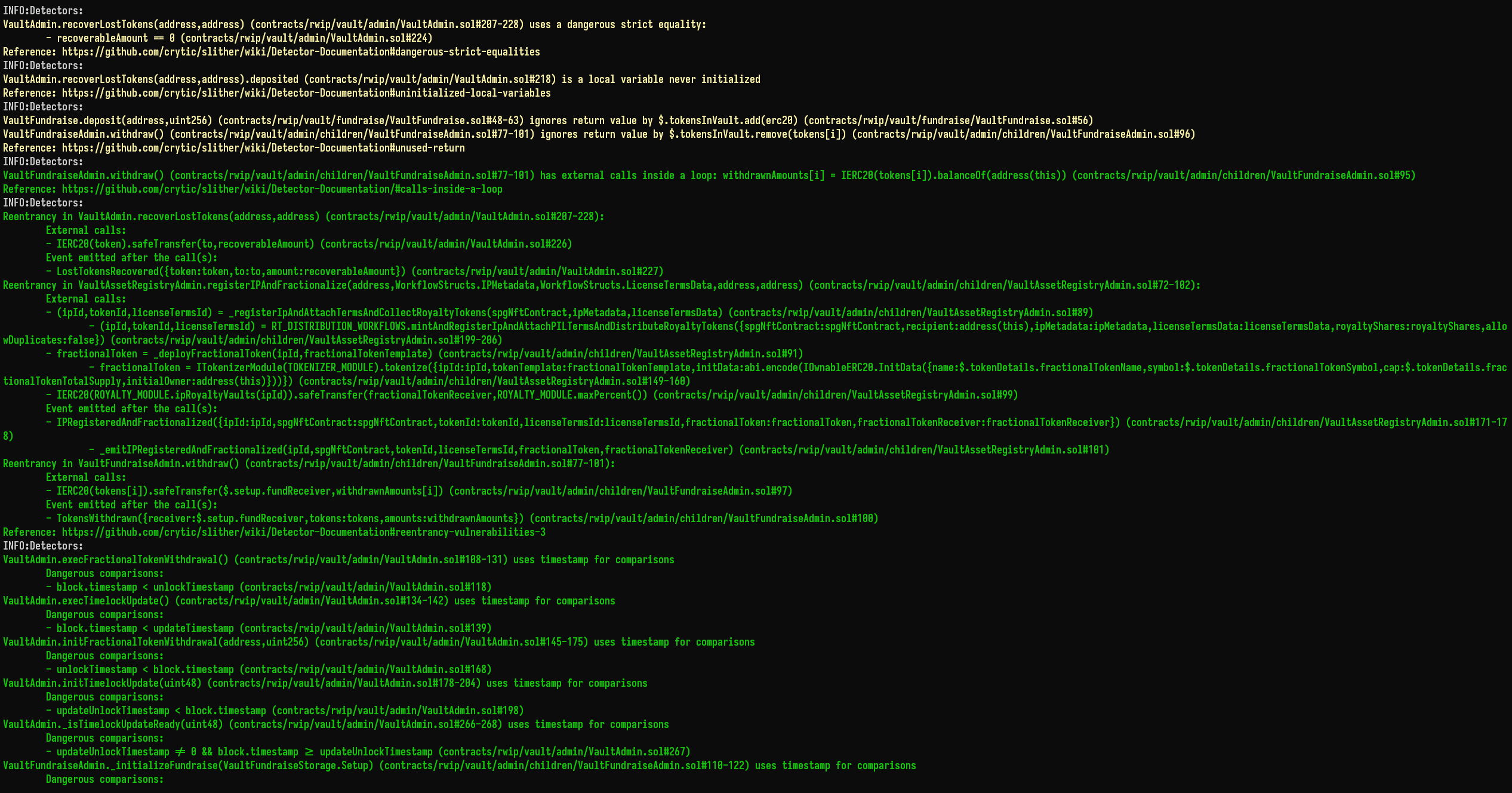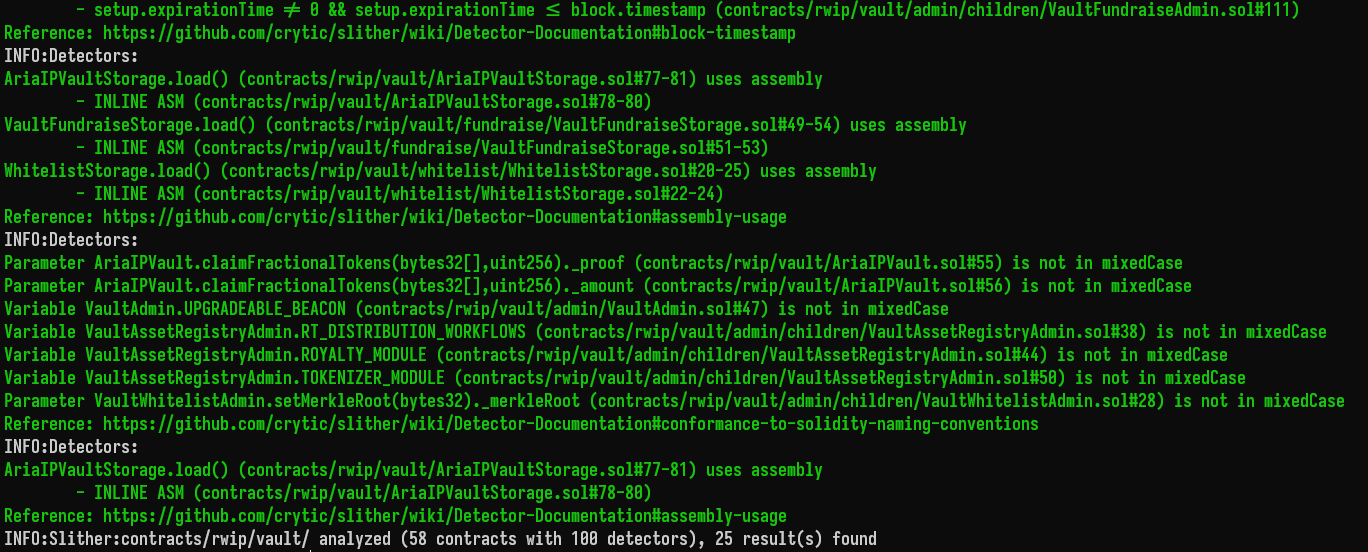Prepared by:
HALBORN
Last Updated 05/27/2025
Date of Engagement: April 28th, 2025 - May 1st, 2025
Summary
100% of all REPORTED Findings have been addressed
All findings
7
Critical
0
High
0
Medium
0
Low
2
Informational
5
Table of Contents
- 1. Introduction
- 2. Assessment summary
- 3. Test approach and methodology
- 4. Static analysis report
- 5. Risk methodology
- 6. Scope
- 7. Assessment summary & findings overview
- 8. Findings & Tech Details
- 8.1 Missing state validation in claimfractionaltokens() function
- 8.2 Missing usdc address validation in fundraise initialization
- 8.3 Lack of uniqueness validation for token identifiers across vaults
- 8.4 Contract size too big for deployment
- 8.5 Suboptimal modifier ordering
- 8.6 Floating pragma
- 8.7 Unused import
1. Introduction
Aria Protocol engaged Halborn to conduct a security assessment on their smart contracts beginning on April 28th, 2025 and ending on May 1st, 2025. The security assessment was scoped to the smart contracts provided to Halborn. Commit hashes and further details can be found in the Scope section of this report.
The Aria Protocol codebase in scope mainly consists of smart contracts for creating and managing intellectual property (IP) vaults that enable the tokenization and fractionalization of IP assets, with support for fundraising and whitelist-based distribution mechanisms.
2. Assessment Summary
Halborn was provided 4 days for the engagement and assigned 1 full-time security engineer to review the security of the smart contracts in scope. The engineer is a blockchain and smart contract security expert with advanced penetration testing and smart contract hacking skills, and deep knowledge of multiple blockchain protocols.
The purpose of the assessment is to:
Identify potential security issues within the smart contracts.
Ensure that smart contract functionality operates as intended.
In summary, Halborn identified some improvements to reduce the likelihood and impact of risks, which were partially addressed by the Aria Protocol team. The main ones are the following:
Add the _checkAndUpdateState() call at the beginning of both claimFractionalTokens() implementations.Consider implementing proper validation of the USDC address.Consider implementing a registry mechanism at the factory level to track and validate token identifiers.
All addressed findings have been consolidated and incorporated into version v1.0.5, available in the following commit: https://github.com/AriaProtocol/main-contracts/tree/83cbf9a4b2b67f54f524a7daae33e7a49efb2860.
3. Test Approach and Methodology
Halborn performed a combination of manual review of the code and automated security testing to balance efficiency, timeliness, practicality, and accuracy in regard to the scope of this assessment. While manual testing is recommended to uncover flaws in logic, process, and implementation; automated testing techniques help enhance coverage of smart contracts and can quickly identify items that do not follow security best practices.
The following phases and associated tools were used throughout the term of the assessment:
Research into architecture, purpose and use of the platform.
Smart contract manual code review and walkthrough to identify any logic issue.
Thorough assessment of safety and usage of critical Solidity variables and functions in scope that could led to arithmetic related vulnerabilities.
Local testing with custom scripts (
Foundry).Fork testing against main networks (
Foundry).Static analysis of security for scoped contract, and imported functions (
Slither).
4. Static Analysis Report
4.1 Description
Halborn used automated testing techniques to enhance the coverage of certain areas of the smart contracts in scope. Among the tools used was Slither, a Solidity static analysis framework. After Halborn verified the smart contracts in the repository and was able to compile them correctly into their abis and binary format, Slither was run against the contracts. This tool can statically verify mathematical relationships between Solidity variables to detect invalid or inconsistent usage of the contracts' APIs across the entire code-base.
The security team assessed all findings identified by the Slither software, however, findings with related to external dependencies are not included in the below results for the sake of report readability.
4.2 Output
The findings obtained as a result of the Slither scan were reviewed, and some were not included in the report because they were determined as false positives.


5. RISK METHODOLOGY
5.1 EXPLOITABILITY
Attack Origin (AO):
Attack Cost (AC):
Attack Complexity (AX):
Metrics:
| EXPLOITABILITY METRIC () | METRIC VALUE | NUMERICAL VALUE |
|---|---|---|
| Attack Origin (AO) | Arbitrary (AO:A) Specific (AO:S) | 1 0.2 |
| Attack Cost (AC) | Low (AC:L) Medium (AC:M) High (AC:H) | 1 0.67 0.33 |
| Attack Complexity (AX) | Low (AX:L) Medium (AX:M) High (AX:H) | 1 0.67 0.33 |
5.2 IMPACT
Confidentiality (C):
Integrity (I):
Availability (A):
Deposit (D):
Yield (Y):
Metrics:
| IMPACT METRIC () | METRIC VALUE | NUMERICAL VALUE |
|---|---|---|
| Confidentiality (C) | None (C:N) Low (C:L) Medium (C:M) High (C:H) Critical (C:C) | 0 0.25 0.5 0.75 1 |
| Integrity (I) | None (I:N) Low (I:L) Medium (I:M) High (I:H) Critical (I:C) | 0 0.25 0.5 0.75 1 |
| Availability (A) | None (A:N) Low (A:L) Medium (A:M) High (A:H) Critical (A:C) | 0 0.25 0.5 0.75 1 |
| Deposit (D) | None (D:N) Low (D:L) Medium (D:M) High (D:H) Critical (D:C) | 0 0.25 0.5 0.75 1 |
| Yield (Y) | None (Y:N) Low (Y:L) Medium (Y:M) High (Y:H) Critical (Y:C) | 0 0.25 0.5 0.75 1 |
5.3 SEVERITY COEFFICIENT
Reversibility (R):
Scope (S):
Metrics:
| SEVERITY COEFFICIENT () | COEFFICIENT VALUE | NUMERICAL VALUE |
|---|---|---|
| Reversibility () | None (R:N) Partial (R:P) Full (R:F) | 1 0.5 0.25 |
| Scope () | Changed (S:C) Unchanged (S:U) | 1.25 1 |
| Severity | Score Value Range |
|---|---|
| Critical | 9 - 10 |
| High | 7 - 8.9 |
| Medium | 4.5 - 6.9 |
| Low | 2 - 4.4 |
| Informational | 0 - 1.9 |
6. SCOPE
- contracts/rwip/vault/admin/VaultAdmin.sol
- contracts/rwip/vault/admin/children/VaultFundraiseAdmin.sol
- contracts/rwip/vault/admin/children/VaultAssetRegistryAdmin.sol
- https://github.com/AriaProtocol/main-contracts/pull/34/commits/3f528415d9f85c83501a41254c6351cc0e90f9fd
- https://github.com/AriaProtocol/main-contracts/pull/33/commits/8e26a6262c6254670d52d32811617e371617a4d9
- https://github.com/AriaProtocol/main-contracts/pull/36/commits/e1bd26cbdee9f8d139804b150c03a993315f19aa
- https://github.com/AriaProtocol/main-contracts/pull/35/commits/ef0dff4d078e91e5d1e9a744cc44922f273f543b
7. Assessment Summary & Findings Overview
Critical
0
High
0
Medium
0
Low
2
Informational
5
| Security analysis | Risk level | Remediation Date |
|---|---|---|
| Missing state validation in claimFractionalTokens() function | Low | Solved - 05/12/2025 |
| Missing USDC address validation in fundraise initialization | Low | Risk Accepted - 05/12/2025 |
| Lack of uniqueness validation for token identifiers across vaults | Informational | Acknowledged - 05/12/2025 |
| Contract size too big for deployment | Informational | Solved - 05/12/2025 |
| Suboptimal modifier ordering | Informational | Acknowledged - 05/12/2025 |
| Floating pragma | Informational | Solved - 05/12/2025 |
| Unused import | Informational | Solved - 05/12/2025 |
8. Findings & Tech Details
8.1 Missing state validation in claimFractionalTokens() function
//
Description
BVSS
Recommendation
Remediation Comment
Remediation Hash
References
8.2 Missing USDC address validation in fundraise initialization
//
Description
BVSS
Recommendation
Remediation Comment
References
8.3 Lack of uniqueness validation for token identifiers across vaults
//
Description
BVSS
Recommendation
Remediation Comment
References
8.4 Contract size too big for deployment
//
Description
BVSS
Recommendation
Remediation Comment
Remediation Hash
References
8.5 Suboptimal modifier ordering
//
Description
BVSS
Recommendation
Remediation Comment
References
8.6 Floating pragma
//
Description
BVSS
Recommendation
Remediation Comment
Remediation Hash
References
8.7 Unused import
//
Description
BVSS
Recommendation
Remediation Comment
Remediation Hash
References
Halborn strongly recommends conducting a follow-up assessment of the project either within six months or immediately following any material changes to the codebase, whichever comes first. This approach is crucial for maintaining the project’s integrity and addressing potential vulnerabilities introduced by code modifications.
Table of Contents
- 1. Introduction
- 2. Assessment summary
- 3. Test approach and methodology
- 4. Static analysis report
- 5. Risk methodology
- 6. Scope
- 7. Assessment summary & findings overview
- 8. Findings & Tech Details
- 8.1 Missing state validation in claimfractionaltokens() function
- 8.2 Missing usdc address validation in fundraise initialization
- 8.3 Lack of uniqueness validation for token identifiers across vaults
- 8.4 Contract size too big for deployment
- 8.5 Suboptimal modifier ordering
- 8.6 Floating pragma
- 8.7 Unused import
// Download the full report
Vault Contracts
* Use Google Chrome for best results
** Check "Background Graphics" in the print settings if needed
